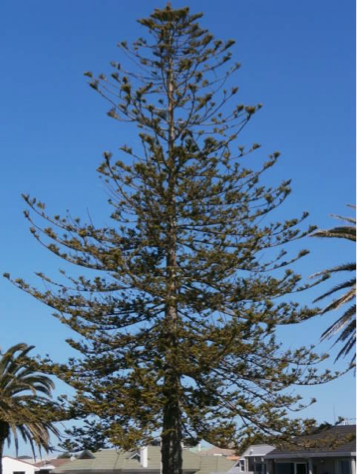PESTS AND DISEASES OF FORESTRY IN NEW ZEALAND
Norfolk Island pine treatment trials
Scion is the leading provider of forest-related knowledge in New Zealand
Formerly known as the Forest Research Institute, Scion has been a leader in research relating to forest health for over 50 years. The Rotorua-based Crown Research Institute continues to provide science that will protect all forests from damage caused by insect pests, pathogens and weeds. The information presented below arises from these research activities.
From Forest Health News No. 242, November 2013.
Several Norfolk Island pines (Araucaria heterophylla) along Mount Maunganui’s Marine Parade and Pilot Bay are suffering from an unidentified disorder. Tauranga City Council is concerned that if the trees continue to decline, they may have to be removed.

Scion has been investigating the cause of the disorder and in consultation with the Tauranga City Council have conducted a preliminary treatment trial aimed at improving tree health. This took place in early October.
The cause of the decline has not yet been determined and it is suspected that it is a combination of pathogens, site disturbances and the severe drought conditions earlier in the year.
Trees are often stressed in urban environments owing to a variety of factors, the foremost being that they are outside their natural environment and exposed to foreign climatic and biological conditions. Other factors may include root damage from lawn mowing or vehicles, pollution or human interference. The drought conditions earlier in the year are likely to have contributed to tree stress in this situation. When trees are stressed they may be less capable of taking up micronutrients from the soil.
A course of treatment on the severely affected trees is being trialled that will help diagnose the cause of the decline and boost their overall health.
The trees have been injected with two applications that are used routinely an in agriculture:
- Phosphite, a biodegradable salt that is widely used to control certain pathogens, and
- Micronutrients to boost the tree health.
The trial includes 21 trees which are showing the most significant decline.
The treated trees will be closely monitored for signs of recovery over the next two years. If the treatment proves successful, this method may be used in further research aimed at improving the health of declining Norfolk Island pines.
In the early 1980s many Norfolk Island pines along the Napier foreshore were showing signs of decline. This was associated with high populations of golden mealybugs (Nipaecoccus aurilanatus), an Australian species that was first found in New Zealand in 1890. It was, in fact, first described from New Zealand. The golden mealybug is normally well controlled by an introduced ladybird (Cryptolaemus montrouzeri) but these efficient predators were not found on the Napier Norfolk Island pines when they were examined by an entomologist in 1983. This
no doubt accounted for the high numbers of golden mealybugs.
Cryptolaemus montrouzeri was introduced into New Zealand from Australia in several consignments between the 1890s and the 1920s. It is a general mealybug predator.
Golden mealybugs have not been implicated in the decline of the Norfolk Island pines in Tauranga although it has been recorded from that host there in the past.
Peter Scott & John Bain
This information is intended for general interest only. It is not intended to be a substitute for specific specialist advice on any matter and should not be relied on for that purpose. Scion will not be liable for any direct, indirect, incidental, special, consequential or exemplary damages, loss of profits, or any other intangible losses that result from using the information provided on this site.
(Scion is the trading name of the New Zealand Forest Research Institute Limited.)

 Farm Forestry New Zealand
Farm Forestry New Zealand

